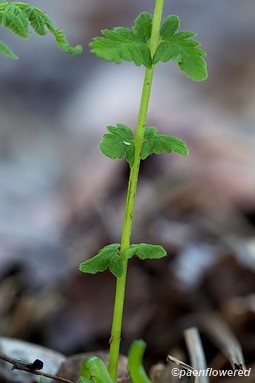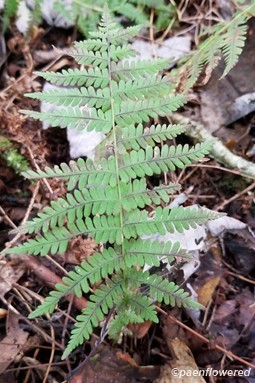Thelypteris noveboracensis
Thelypteris noveboracensis New York fern
A relatively common, light green, delicate fern that grows in colonies, and spreads through woodlands where there is sufficient sunlight. The blade tapers at both tips and makes a 'stair case' from the pinnae at the bottom. This fern is decidious and turns golden brown in the fall before withering as the weather gets colder.
Habitat & Range
Common in sunny spots of mixed woodlands and drier edges of swamps, vernal seeps in ravines, and near streams.
Range is from Maine to North Carolina, west to Minnesota and Arkansas. Common throughout the northeast.
| EMP: | FAC |
|---|---|
| NCNE: | FAC |
Phenology
Does not overwinter.
Characteristics
Frond 8 to 25 in. long. Grows in tufts of 3 or more fronds along the rhizome. Does not overwinter. Fertile fronds are larger, narrower, and more erect than sterile ones.
Blade tapers from middle up to pointed tip and down to where it joins the rhizome. Widest in the middle. Delicate, thin, yellow-green with fine hair underneath. Cut into 20 or so pairs of alternate, sessile pinnae.
Pinnae long, pointed, narrow, lance-shaped; cut nearly to mid-vein into narrow, rounded lobes. Lowest pinnae often minute in size, appearing almost at ground level on the rachis. Veins rarely forked.
Rachis green, pale, smooth or slightly hairy
Stipe 2 to 10 in. long. Either straw-colored or light green, smooth or slightly hairy above, brown and with a few golden to reddish-brown scales at base.
Rhizome dark brown, slender, slightly scaly, widely creeping and branching, yet produces fronds in tufts.
Sori few, round, small, near margins. Indusium kidney-shaped; pale tan, somewhat hairy.
Special Characters
The lowest pinnae are located low on the rachis, often almost to the ground, and form a sort of 'stair-case' tapering in size going down.
Plant Codes
S-rank: No Rank
G-rank: G5 (Secure)













